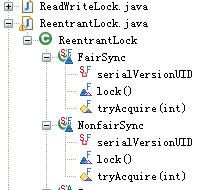一、前言
ReentrantLock是JDK1.5引入的,它拥有与synchronized相同的并发性和内存语义,并提供了超出synchonized的其他高级功能(例如,中断锁等候、条件变量等),并且使用ReentrantLock比synchronized能获得更好的可伸缩性。
ReentrantLock的实现基于AQS(AbstractQueuedSynchronizer)和LockSupport。
AQS主要利用硬件原语指令(CAS compare-and-swap),来实现轻量级多线程同步机制,并且不会引起CPU上文切换和调度,同时提供内存可见性和原子化更新保证(线程安全的三要素:原子性、可见性、顺序性)。
AQS的本质上是一个同步器/阻塞锁的基础框架,其作用主要是提供加锁、释放锁,并在内部维护一个FIFO等待队列,用于存储由于锁竞争而阻塞的线程。
二、关键代码分析
1.关键字段
AQS使用链表作为队列,使用volatile变量state,作为锁状态标识位。
2.ReentrantLock的公平锁与非公平锁
从ReentrantLock的构造子可以看到,ReentrantLock提供两种锁:公平锁和非公平锁,其内部实现了两种同步器NonfairSync、FairSync派生自AQS,主要才采用了模板方法模式,主要重写了AQS的tryAcquire、lock方法,如下图。
3.获取锁操作
public void lock() {
sync.lock();
}
由于NonfairSync、FairSync分别实现了lock方法,我们将分别探讨
3.1NonfairSync.lock()分析
(1)通过原子的比较并设置操作,如果成功设置,说明锁是空闲的,当前线程获得锁,并把当前线程设置为锁拥有者;
(2)否则,调用acquire方法;
3.1.1acquire方法分析
(1)如果尝试以独占的方式获得锁失败,那么就把当前线程封装为一个Node,加入到等待队列中;如果加入队列成功,接下来检查当前线程的节点是否应该等待(挂起),如果当前线程所处节点的前一节点的等待状态小于0,则通过LockSupport挂起当前线程;无论线程是否被挂起,或者挂起后被激活,都应该返回当前线程的中断状态,如果处于中断状态,需要中断当前线程。
3.1.2nonfairTryAcquire分析
(1)如果锁状态空闲(state=0),且通过原子的比较并设置操作,那么当前线程获得锁,并把当前线程设置为锁拥有者;
(2)如果锁状态空闲,且原子的比较并设置操作失败,那么返回false,说明尝试获得锁失败;
(3)否则,检查当前线程与锁拥有者线程是否相等(表示一个线程已经获得该锁,再次要求该锁,这种情况叫可重入锁),如果相等,维护锁状态,并返回true;
(4)如果不是以上情况,说明锁已经被其他的线程持有,直接返回false;
3.1.3addWaiter分析
(1)如果tail节点不为null,说明队列不为空,则把新节点加入到tail的后面,返回当前节点,否则进入enq进行处理(2);
(2)如果tail节点为null,说明队列为空,需要建立一个虚拟的头节点,并把封装了当前线程的节点设置为尾节点;另外一种情况的发生,是由于在(1)中的compareAndSetTail可能会出现失败,这里采用for的无限循环,是要保证当前线程能够正确进入等待队列;
3.1.4acquire分析
(1)如果当前节点是队列的头结点(如果第一个节点是虚拟节点,那么第二个节点实际上就是头结点了),就尝试在此获取锁tryAcquire(arg)。如果成功就将头结点设置为当前节点(不管第一个结点是否是虚拟节点),返回中断状态。否则进行(2)。
(2)检测当前节点是否应该park()-"挂起的意思",如果应该park()就挂起当前线程并且返回当前线程中断状态。进行操作(1)。
3.1.5 shouldParkAfterFailedAcquire分析
(1)如果前一个节点的等待状态waitStatus<0,也就是前面的节点还没有获得到锁,那么返回true,表示当前节点(线程)就应该park()了。否则进行(2)。
(2)如果前一个节点的等待状态waitStatus>0,也就是前一个节点被CANCELLED了,那么就将前一个节点去掉,递归此操作直到所有前一个节点的waitStatus<=0,进行(4)。否则进行(3)。
(3)前一个节点等待状态waitStatus=0,修改前一个节点状态位为SINGAL,表示后面有节点等待你处理,需要根据它的等待状态来决定是否该park()。进行(4)。
(4)返回false,表示线程不应该park()。
注意:一个Node节点可包含以下状态以及模式:
/** waitStatus value to indicate thread has cancelled */ 取消
static final int CANCELLED = 1;
/** waitStatus value to indicate successor's thread needs unparking */ 信号等待(在AQS中,是通过LockSupport进行线程间信号交互的)
static final int SIGNAL = -1;
/** waitStatus value to indicate thread is waiting on condition */ 条件等待
static final int CONDITION = -2;
/** Marker to indicate a node is waiting in shared mode */ 共享模式
static final Node SHARED = new Node();
/** Marker to indicate a node is waiting in exclusive mode */ 独占模式
static final Node EXCLUSIVE = null;
3.2FairSync.lock()分析
公平锁相对与非公平锁,在锁的获取实现上,差别只在FairSync提供自己的tryAcquire()的方法实现,代码如下:
(1)如果锁状态为0,等待队列为空,或者给定的线程在队列的头部,那么该线程获得锁;
(2)如果当前线程与锁持有者线程相等,这种情况属于锁重入,锁状态加上请求数;
(3)以上两种情况都不是,返回false,说明尝试获得锁失败;
4.总结
ReentrantLock在采用非公平锁构造时,首先检查锁状态,如果锁可用,直接通过CAS设置成持有状态,且把当前线程设置为锁的拥有者。
如果当前锁已经被持有,那么接下来进行可重入检查,如果可重入,需要为锁状态加上请求数。如果不属于上面两种情况,那么说明锁是被其他线程持有,
当前线程应该放入等待队列。
在放入等待队列的过程中,首先要检查队列是否为空队列,如果为空队列,需要创建虚拟的头节点,然后把对当前线程封装的节点加入到队列尾部。由于设置尾部节点采用了CAS,为了保证尾节点能够设置成功,这里采用了无限循环的方式,直到设置成功为止。
在完成放入等待队列任务后,则需要维护节点的状态,以及及时清除处于Cancel状态的节点,以帮助垃圾收集器及时回收。如果当前节点之前的节点的等待状态小于1,说明当前节点之前的线程处于等待状态(挂起),那么当前节点的线程也应处于等待状态(挂起)。挂起的工作是由LockSupport类支持的,LockSupport通过JNI调用本地操作系统来完成挂起的任务(java中除了废弃的suspend等方法,没有其他的挂起操作)。
在当前等待的线程,被唤起后,检查中断状态,如果处于中断状态,那么需要中断当前线程。
